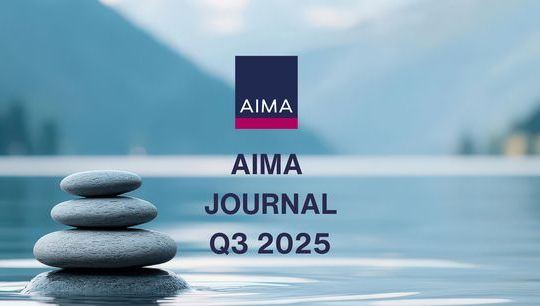AIMA/CAIA: Portfolio Transformers - Examining the role of hedge funds as substitutes and diversifiers in investor portfolios
By AIMA & CAIA Association
Published: 16 November 2018

The following is an online summary of this particular AIMA paper
Foreword
By Mark Anson
Comparatively little educational material about hedge funds and other alternative investments has been written for trustees and other fiduciaries. And so at the beginning of 2015, AIMA and the CAIA Association embarked on a long-term joint programme to produce accessible information about hedge funds for this important but under-served audience.
AIMA and CAIA’s first paper, titled ‘The Way Ahead: Helping Trustees Navigate the Hedge Fund Sector’, set out hedge funds’ core value proposition while objectively discussing some of the challenges that investors face when considering a
hedge fund allocation.
In this second paper, ‘Portfolio Transformers: Examining the Roles of Hedge Funds as Substitutes and Diversifiers’, AIMA and CAIA have sought to build on this foundation by providing a more detailed guide to how hedge funds can adapt and diversify portfolios of investors such as endowments and foundations, pension funds, insurance companies, private family offices and sovereign wealth funds.
Investment mandates vary from investor to investor. There is no one size fits all. These differences in objectives naturally lead to differences in overall asset allocations, risk-return profiles and the like, with the possible inclusion of hedge funds performing different roles and thus satisfying different risk and return objectives.
Increasingly, institutional investors consider an allocation to hedge funds as playing the role of either a substitute or a diversifier within their total portfolio. Where investors view hedge funds as taking on the role of a substitute and/or complement, they may allocate to certain hedge fund strategies to replace some or all of their investment in traditional long-only equity, credit and/or fixed income investments. Such hedge fund strategies ought to reduce the overall volatility (i.e. reduce the risk) of the portfolio’s public markets allocation, with a more attractive risk/reward profile. Other hedge fund strategies may have a low correlation to equity and credit markets and offer a higher probability of generating out-sized returns (albeit by taking on a higher level of risk).
The paper reflects how the hedge fund industry has grown and matured over the last 15 years. Since the bursting of the tech bubble in 2000, when hedge funds generally outperformed, assets under management in the hedge fund industry have grown from about $500 billion to over $3 trillion. Much of this growth came from institutional investors, who have allocated to hedge funds primarily for three reasons:
1) To access investment strategies that were outside of the domain of traditional asset managers;
2)To take advantage of investment opportunities on both the long and the short side of the market; or
3) To find manager skill that may not reside in the traditional world of long-only asset management.
However, as the hedge fund industry has matured, there are new reasons why sophisticated investors seek out hedge funds:
- For risk budgeting − building a hedge fund portfolio with a lower volatility than the traditional equity markets. The hedge fund portfolio effectively “buys” risk units that can then be “spent” on more risky parts of the portfolio
- This strategy is increasingly used by institutional investors to get more “return buck” for the risk taken.
- As a fixed income substitute by building a hedge fund portfolio that is market neutral but offers higher yields than traditional bonds.
- Low bond yields across the developed markets make bonds a poor investment decision for diversification, liability matching, and risk dampening.
- As a replacement for traditional asset management. While in the past, hedge funds were used as a complement to a
- long-only portfolio, investors are increasingly allocating to hedge funds as their primary equity, bond or credit strategy.
- Sophisticated investors are replacing their long-only managers with long-short managers who manage either a beta or volatility target such that the institutional investor gets the same level of asset class exposure but with higher expected returns for the risk underwritten.
However, these are but a sample of the strategies that institutional investors pursue with respect to hedge funds. Given their individual pension obligations, university budgets, philanthropic goals, or insurance payment schedules, the liability streams of institutional investors is as varied as the colours in a rainbow. This is the beauty of hedge funds, whose investment strategies and styles can match these many-varied liability streams with a matching set of colours.
We all can agree that the future is uncertain. No institutional investor can predict with 100% accuracy what liability stream they will need to fund in the future. But hedge funds, as is explained in this paper, can help to bridge this uncertainty gap. The variety, fluidity and sheer creativity of their investment strategies provides the flexibility to adapt to any uncertain liability stream that can be constructed by an institutional investor. In that way, hedge funds have evolved into solution providers − and portfolio transformers.
Mark Anson is the President and Chief Investment Officer of Acadia Capital, the Bass family offi ce. He is also a Board Director of the CAIA Association and a Member of the AIMA Investor Steering Committee.
Introduction
It is time to think about hedge funds in a new way.
The old distinctions that have underpinned portfolio construction for at least the last 25 years are rapidly disappearing. Many of the most experienced hedge fund allocators worldwide no longer see hedge funds as a separate bucket − ring-fenced, somehow, from the “traditional” assets in a portfolio − but as substitutes for long-only investments and diversifiers capable of transforming the risk and return characteristics of their entire portfolios.
Take the substitutes. Those investors who, for example, are now choosing to replace some of their long-only equities allocation with an equity hedge fund are not merely substituting a long-only allocation with a hedged position. They are also improving the way their portfolio as a whole performs under a variety of market conditions due to hedge funds’ superior risk-adjusted characteristics over time. The result of all this − the capital of the investor is better preserved while its’ volatility is also reduced across the entire equities allocation.
Some hedge funds are simply too uncorrelated to equities, say, to be a straight swap − since the way they behave under certain market conditions is substantially different to the way the underlying asset class behaves. These hedge funds are not regarded by hedge fund allocators as substitutes, but as diversifiers.
All hedge funds offer diversification. But the diversifiers (in this context) comprise hedge fund strategies that are particularly uncorrelated to the underlying traditional assets in the portfolio − and thus, provide the potential for significant diversification and the highest possibility of generating out-performance.
Which hedge funds are substitutes and which are diversifiers? For this paper, new analysis has been undertaken − using a statistical method known as cluster analysis − to accurately categorise the risk and return characteristics of the main hedge fund strategy types. This is what the analysis has found:
| Substitutes | Diversifiers |
| ● Long/short equity funds | ● Global macro funds |
| ● Long/short credit funds | ● Managed futures funds/CTAs |
| ● Event driven funds | ● Equity market-neutral funds |
| ● Fixed income arbitrage funds | |
| ● Convertible arbitrage funds | |
| ● Emerging markets funds |
Thinking of hedge funds as substitutes or diversifiers poses an intriguing, final question: what is the optimum split in a portfolio between hedge funds and long-only investments? We do not, in this paper, seek to answer this question directly, since we recognise that institutional investors are not a homogeneous group. Pensions, endowments, foundations, insurers and family offices are very different entities, with different challenges and divergent aims and objectives.
But the logical conclusion of this new thinking points to a future in which investors no longer have a target hedge fund allocation in mind − say, 15% or 20% of the total portfolio − but rather, they view hedge funds as another method of investing in equities, bonds or other asset classes. It is transformative thinking.
Note: This paper assumes a level of understanding that at a minimum, investment advisors or their equivalent at pension plans (and/or their equivalent standing at other investor types) should understand.







